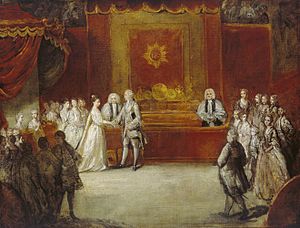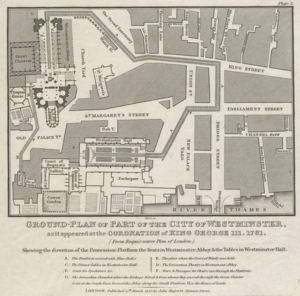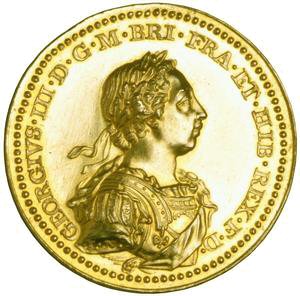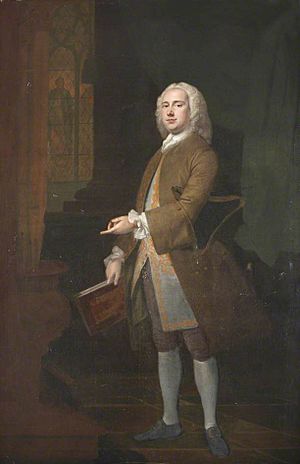Coronation of George III and Charlotte facts for kids
|
King George III and Queen Charlotte in coronation robes, by Allan Ramsay
|
|
| Date | 22 September 1761 |
|---|---|
| Location | Westminster Abbey, London, England |
| Budget | £9,430 (£70,000 according to other sources) |
| Participants |
|
The coronation of George III and his wife Charlotte was a huge event. It marked them officially becoming King and Queen of Great Britain and Ireland. This special ceremony happened at Westminster Abbey in London on September 22, 1761. It took place just two weeks after they got married.
The day was full of excitement, but also some mix-ups! The parade from Westminster Hall to the Abbey was late. Then, the coronation service itself lasted for six hours. Finally, a big dinner party ended the long day at ten o'clock at night.
Contents
Becoming King: George III's Story

George became king on October 25, 1760, when his grandfather, George II, passed away. George was only 22 years old at the time. He wasn't married yet, so he needed to find a queen.
He asked his advisor, Lord Bute, to help him find a suitable princess. In July 1761, they chose 17-year-old Princess Charlotte of Mecklenburg-Strelitz. George liked that she wasn't very interested in politics.
Princess Charlotte arrived in London on September 8, 1761. She met King George and they got married the very same day! Their wedding took place at the Chapel Royal, St James's Palace. This meant they were married just in time for their big coronation ceremony two weeks later.
Getting Ready for the Big Day
The coronation was a very expensive event. It cost about £9,430, though some say it was closer to £70,000! Traditionally, a special person called the Earl Marshal was in charge of the ceremony. However, the Earl Marshal at the time, Edward Howard, was Catholic, so he couldn't do the job. His relative, Thomas Howard, took his place.
The Archbishop of Canterbury, Thomas Secker, was in charge of the church service. He made only small changes to the old ceremony. He added parts for the Queen's coronation. He also made sure to mention that Britain was fighting a war at the time.
Westminster Abbey was completely changed for the event. Many wooden balconies were built inside for important people like Members of Parliament and musicians. In the main part of the Abbey, three levels of seating were built for the public. A front-row seat cost 10 guineas (about £10.50). A private box with twelve seats cost 50 guineas (about £52.50).
Westminster Hall was also transformed. It was usually divided into courtrooms. For the coronation, a wooden floor was put in, along with three levels of seating for people watching. The highest seats were attached to the roof! A grand arch was built over the north door. It had a balcony for musicians and a pipe organ. Twenty-five huge chandeliers lit up the hall.
Outside, builders put up temporary stands for people to watch the parade. Some stands could hold up to 1,500 people. Renting a house with a view of the parade for the day could cost as much as £1,000!
A special carriage called the Gold State Coach was ordered for the coronation. It was a fancy, eight-horse-drawn carriage. It cost £7,562, which would be millions of dollars today! However, it wasn't ready in time for George III's coronation. It was finished in 1762 and has been used for every British monarch's coronation since 1831.
The Grand Parade
Everyone was very excited for the coronation. On the morning of the ceremony, the streets were packed with people. Inns and homes were overflowing with guests waiting to see the new King and Queen. Many carriages rushed to Westminster Abbey, causing a bit of a traffic jam!
Around 9:00 AM, George and Charlotte left St James's Palace. They were carried separately in special chairs to Westminster Hall. Important people like nobles, government officials, and royal staff had already gathered there.
Following an old tradition, everyone in the hall waited for a parade of church leaders from the Abbey. They brought the crowns and other royal items. These were then given to the people who would carry them in the main parade to the Abbey.
There was a long delay because the person in charge, the deputy Earl Marshal, forgot some important things! There were no chairs for the King and Queen. There was no special sword for the King, so they had to borrow one from the Lord Mayor of London. There was also no canopy, a special cloth cover, for the King and Queen to walk under. They had to quickly make one up.
The short parade on foot from Westminster Hall to Westminster Abbey was the only part the public could see. Huge crowds filled the sidewalks, windows, and even the roofs of nearby houses. Special wooden stands were also built for people to watch. The parade route had a temporary wooden walkway, about 3 feet high and 15 feet wide. This made it easier to see the participants.
However, 2,800 soldiers stood on either side of the route, blocking the view. They had to push back the eager crowds with their swords and muskets. The King and Queen finally entered the Abbey shortly after 1:30 PM. People commented on how dignified they looked and how respectfully they paid attention to the service. The parade and ceremony were so long that the King wasn't crowned until 3:30 that afternoon!
The Coronation Service
Archbishop Secker led the coronation ceremony. The first part was the "recognition and oath." The people in the Abbey had to shout "God save King George!" to show they accepted him. Then, the King swore and signed his coronation oath.
After this, a short 15-minute speech was given by the Bishop of Salisbury. Next came the "anointing" with holy oil. Then, the King was given the royal items, like the orb and scepter. The most important moment was when the Archbishop placed the crown on the King's head. This happened at 3:30 PM.
Trumpets played loudly in the Abbey. A person on the roof signaled for cannons to fire in Green Park and at the Tower of London. After being crowned, the King sat on his throne. Each of the nobles then came forward to promise their loyalty. During this part, gold and silver coronation medallions were thrown out to the crowd.
Then, the Queen had her shorter crowning ceremony. Finally, the King and Queen took part in a special religious service. After changing out of their heavy robes, the King, Queen, nobles, and bishops walked back to Westminster Hall. The service had lasted six hours, and it was already dark when they left the Abbey.
Funny Moments and Mistakes
The coronation day had a few funny or awkward moments:
- On the way to the Abbey, the Bishop of Rochester almost dropped the crown he was carrying! Luckily, it was pinned to its cushion.
- One person watching said the royal messengers made "numerous mistakes and stupidities." Another called the whole thing "confusion, irregularity and disorder."
- The King felt it was wrong to take part in the religious service while wearing his crown. He asked the Archbishop if he should take it off. The Archbishop didn't know the answer, and neither did the Dean of Westminster! The King took it off anyway.
- At one point, a large jewel supposedly fell from the King's crown. Some people later said this was a bad sign for the future, predicting American Independence.
- During the speech, people in the main part of the Abbey couldn't hear. They started eating cold meat and pies and drinking wine that servants brought them. The clatter of forks and plates made everyone laugh!
- The Queen wanted to use a special private room built for her. But she found it was already being used by the Prime Minister, the Duke of Newcastle!
- When the King complained about these problems to the Earl Marshal, he admitted there had been "some neglect." But he joked that he would make sure the next coronation would be organized properly (knowing, of course, that the King would be dead by then!). George found this very funny and made him repeat it several times.
The Music of the Day
The 1761 coronation is special because almost all the music was written by one person: William Boyce. He was the "Master of the King's Music." Boyce thought he was supposed to write all new music for the ceremony. He wrote eight new songs for the service.
However, he decided not to rewrite the famous song Zadok the Priest. He said it couldn't be better than how Mr. Handel had already written it. The Archbishop agreed, and Handel's version of Zadok has been used at every coronation since! Boyce's song for the entrance, I was glad, was probably sung in two parts. This allowed the boys from Westminster School to shout their traditional cheer, Vivat!
The choirs from Westminster Abbey and the Chapel Royal had about 42 singers. There was also an orchestra with about 105 musicians. The music seems to have been the only part of the coronation that went perfectly. This might be because Boyce held three full rehearsals in the Abbey. People could even buy tickets to watch these rehearsals!
The Coronation Dinner
The long day ended with a grand dinner party called the coronation banquet. Important officials rode on horseback inside the hall. The guests had to sit in the dark until the King and Queen arrived. Then, all 3,000 candles were lit almost at once! This was spectacular, but it also showered the guests with flakes of ash.
Again, there were some organization problems. Much of the blame went to the Lord Steward, William Talbot. He was known for his "swaggering manners." There were no tables for some important groups, like the Barons of the Cinque Ports and the aldermen of the City of London. They were supposed to have special places. The aldermen ended up taking the table meant for the Knights of the Bath, who then had to move. The unhappy Cinque Port barons were only quieted when Talbot challenged them to a duel!
Talbot had trained his horse to walk backward away from the thrones. But the horse kept entering the hall backward, with its rear end facing the King! This made many people watching laugh.
Between the first and second courses of the meal, a special person called the King's Champion entered the hall. He was John Dymoke, dressed in full armor. He was supposedly riding the same gray horse that King George II had ridden in a battle eighteen years earlier. People watching from above would lower baskets and handkerchiefs to the diners below. The diners would then send up chicken and wine!
The dinner finally ended at 10 PM when the King and Queen left in their chairs. As was the tradition, the doors of the hall were then opened to the public. People rushed in and took anything that was left behind, including plates, cutlery, and tablecloths!
Other Celebrations
In London, large crowds celebrated in the streets. The government had forbidden bonfires for safety reasons. But many people ignored this, even with soldiers patrolling. The Prime Minister, the Duke of Newcastle, had a bonfire lit outside his home. He gave away beer to the crowds. Others lit up their houses with lanterns.
Elsewhere, Coronation Day was celebrated with special church services, big dinners, fireworks, and feasts for the poor. In the weeks that followed, theatres in London put on plays that recreated the coronation. One show even had "a real bonfire and a real mob" on stage! Another production featured the actual choir from Westminster Abbey.
Images for kids








